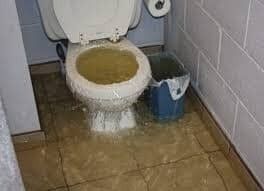
Sewage Backup: A Major Plumbing Issue
Sewage backup is a serious and unpleasant plumbing issue that can cause significant damage to your property and pose health risks. It occurs when the sewer lines, which are responsible for transporting wastewater to the municipal sewage system or septic tank, become compromised. Sewage backup can result from various factors, such as clogged sewer lines, tree root intrusion, or a damaged sewer pipe.
Risks Associated with Sewage Backup

Sewage backup can have several risks and consequences, including:
- Spread of harmful bacteria, viruses, and other pathogens
- Foul odor and unsanitary conditions
- Potential contamination of personal belongings
- Destruction of building materials and furniture
- Allergic reactions and respiratory issues due to mold growth
- Potential damage to electrical systems
Given these risks, it is crucial to address sewage backup promptly and professionally to ensure the safety of your property and its occupants.
Proper Cleanup Procedures
When faced with a sewage backup, it is important to take immediate action and follow proper cleanup procedures. Here are the steps involved in sewage backup cleanup:

- Ensure personal safety: Before starting any cleanup tasks, it is essential to prioritize personal safety. Put on personal protective equipment (PPE), including gloves, masks, and boots, to minimize exposure to harmful pathogens.
- Stop the source: If possible, determine the source of the sewage backup and stop the flow of wastewater. This may involve shutting off the water supply or contacting a professional plumber.
- Call professionals: Sewage backup cleanup is a complex and hazardous task that is best left to professionals. Contact a reputable water damage restoration company with experience in handling sewage backups.
- Assessment and extraction: The restoration professionals will assess the extent of the damage and use specialized equipment to extract the sewage and water from your property.
- Clean and disinfect: After the extraction process, the affected areas will be thoroughly cleaned and disinfected to eliminate any remaining pathogens.
- Drying and dehumidification: To prevent mold growth, the property will be dried using high-powered fans and dehumidifiers.
- Sanitize personal belongings: Personal belongings affected by the sewage backup may need to be cleaned, disinfected, and restored. This can include clothing, furniture, and other items.
- Structural repairs: If the sewage backup caused damage to the structure of your property, it will need to be repaired. This may involve replacing drywall, flooring, or other building materials.
- Prevent future backups: To prevent future sewage backups, consider implementing preventive measures such as regular sewer line maintenance, installing backflow prevention devices, and avoiding flushing inappropriate materials down the toilet or drains.
Restoring Personal Belongings After a Sewage Backup
After a sewage backup incident, it’s important to properly clean and restore any personal belongings that may have been affected. Here are some steps to restore personal belongings:
- Separate contaminated items: Sort through your belongings and separate items that have been contaminated by sewage. This may include clothing, bedding, rugs, and other fabric-based materials.
- Remove excess waste: Remove any excess waste or sewage from the surface of the items. Use gloves and dispose of the waste in sealed plastic bags.
- Wash with appropriate cleaning agents: Wash the contaminated items with appropriate cleaning agents, such as a mixture of bleach and water, to eliminate any remaining pathogens. Follow the manufacturer’s instructions and wear protective gloves while handling cleaning agents.
- Dry thoroughly: After washing, ensure that the items are thoroughly dried. This can be done by hanging them outside in the sunlight or using a dryer if appropriate.
- Inspect for damage: After drying, inspect the items for any signs of damage or lingering odor. If necessary, consider professional restoration services for delicate or valuable belongings.
It’s important to note that some items, especially porous materials like mattresses or upholstered furniture, may need to be discarded if they cannot be adequately cleaned and restored.
Sewage Backup Prevention
Prevention is key when it comes to sewage backups. Here are some preventive measures you can take:
- Regularly maintain your sewer lines, including scheduled inspections and cleaning.
- Avoid flushing inappropriate materials like grease, diapers, wipes, or feminine hygiene products down the toilet.
- Install backflow prevention devices, which help prevent sewage from flowing back into your property.
- Be cautious of tree root intrusion and take appropriate measures to prevent root damage to your sewer pipes.
By implementing these preventive measures, you can significantly reduce the risk of future sewage backups.
Frequently Asked Questions (FAQs)
Q: What should I do if I experience a sewage backup?
Q: Can personal belongings be restored after a sewage backup?
Dealing with a sewage backup can be overwhelming, but with proper cleanup procedures and preventive measures, you can minimize the damage and reduce the chances of it happening again. If you require professional assistance with sewage backup cleanup and restoration, contact Water Damage Restoration Pros of Las Vegas at 725-210-8500.


